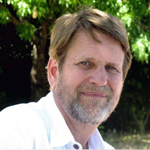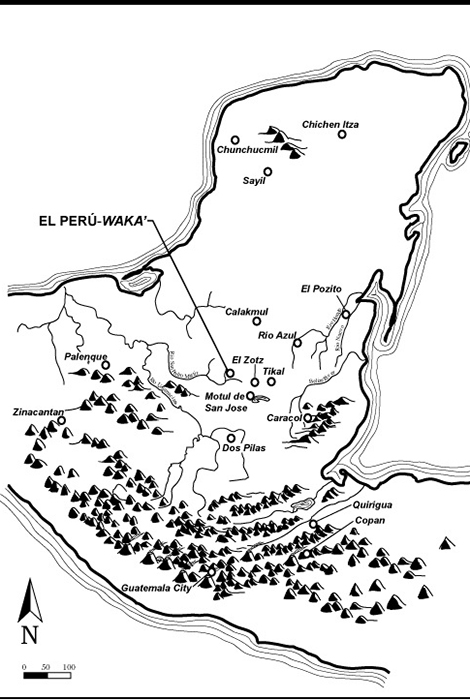
Philanthropist and WUSTL parent Scott Rudolph, left, and Chancellor Emeritus William H. Danforth, right, congratulate Bradley Jolliff on becoming the Scott Rudolph Professor of Earth and Planetary Sciences in Arts & Sciences.
In a ceremony late last year, Bradley L. Jolliff, PhD, became the inaugural Scott Rudolph Professor of Earth and Planetary Sciences (EPS) in Arts & Sciences at Washington University in St. Louis.
Presiding at the event was Chancellor Mark S. Wrighton with special guest Scott Rudolph, philanthropist and WUSTL parent, accompanied by his sons, Michael and Ian.
“On this important occasion, we gather to recognize Brad Jolliff as one of the world’s leading planetary scientists, and to extend our gratitude to Scott and Pyong Rudolph for supporting this endowed professorship, and for their outstanding generosity and commitment to the work being done in Earth and Planetary Sciences and throughout the university,” Wrighton said.
“Earth and Planetary Sciences’ association with the Rudolph family, begun officially with our building’s rededication as Scott Rudolph Hall last May, is now stronger with the establishment of this professorship,” said Douglas Wiens, PhD, professor and chair of the department.
“Professor Brad Jolliff is one of our most outstanding scientists and, thanks to Scott, he will now be on our faculty for many years, giving our students a chance to participate in the geological exploration of other worlds,” Wiens said.
Jolliff joined Washington University in 1988, then took a leave to serve in the Persian Gulf War. He returned in 1992 and since has made important contributions as a teacher and research scientist.
Both undergraduate and graduate students are part of his lab team, which studies surfaces of the moon, Mars and other terrestrial planets. As such, his students become exposed not only to the science, but also to the workings of the many NASA initiatives Jolliff is involved with, among them the Mars exploration rovers, the MoonRise New Frontiers project and the Lunar Reconnaissance Orbiter mission.
To understand the physical properties of these surfaces, Jolliff studies the petrologic and geochemical elements in rocks and minerals, as well as their formation processes and petrogenetic history, through lunar samples, and through Martian materials and terrestrial analogs. Through remote sensing and automated in-situ determination of surface mineralogy of the moon, Mars and other bodies, he and his team are discovering how materials are distributed and how surfaces have evolved over time.
“Understanding how lunar materials got distributed the way they did is important to me, especially if we are ever to use the moon as a resource for further exploration,” Jolliff explained. “The moon is still a hard place to get to.”
“Brad is a superb educator because he teaches students to think like a scientist. This is a critical aspect of our mission at Washington University,” said Barbara A. Schaal, PhD, dean of the Faculty of Arts & Sciences and the Mary-Dell Chilton Distinguished Professor in the Department of Biology in Arts & Sciences.
“In addition to the critical research Brad is involved in, he also is helping shape the quality of scientists to come,” Schaal added. “A number of outstanding graduates have worked in his lab, men and women who are now scientists in their own right and, as future leaders in their fields, will address the nation’s current and future challenges.”
The Rudolphs’ connection with WUSTL began when their oldest son, Michael, entered the university in 2009. Last fall, son Ian joined the Class of 2016, further strengthening their ties. Both Rudolph sons are studying business; Michael graduated this May.
“Since then, the Rudolphs have become a part of our family, embracing our mission for excellence and contributing their time, talent and financial support to that mission,” Wrighton said. “Their generosity seems to know no bounds.”
This professorship is part of a $10 million gift they have given as an investment in people, scholarships, programs and facilities. The couple also provided a $1 million scholarship challenge to support Opening Doors to the Future: The Scholarship Initiative for Washington University.
Rudolph’s connection to the Earth and Planetary Sciences department relates to his avocation, geology and mineral collecting, coupled with his belief that education is the key to moving forward in life.
Foreseeing the rising popularity of vitamins, minerals and nutritional supplements, Rudolph established US Nutrition Inc. in 1977 while still a teenager working out of his parents’ garage in a Long Island suburb. In less than a decade, it was purchased by NBTY (formerly Nature’s Bounty), the world’s largest manufacturer and marketer of nutritional supplements, with Rudolph at the helm as chief executive officer. His new venture, Piping Rock Health Products, represents the next phase of his career in the health and nutrition business.
The Rudolphs are active members of the Parents Council and are sustaining charter members of the Danforth Circle, Chancellor’s Level. Scott Rudolph co-chairs the Parents Committee and is a member of the New York City Executive Committee for Leading Together: The Campaign for Washington University. In addition, he is a member of the Board of Trustees and serves on its Global Engagement Committee; he also serves on the university’s Entrepreneurship National Council.
In 2011, the Rudolphs received Washington University’s Brookings Award, a prestigious honor awarded by the Board of Trustees to recognize outstanding dedication.


























































